ZOLOTE, Ukraine — Before the war, Valentyn serviced the railroads. Now, he is back on the railroad, serving as a Ukrainian army soldier with nom-de-guerre Hornet at a frontline position, where a railway separates government forces and Russian-proxy troops in Donbas.
Along with other soldiers of the 72nd Brigade of the Ukrainian Army, Valentyn, 40, lives in an abandoned apartment building in Zolote. This frontline town in Luhansk Oblast lies some 700 kilometers southeast of Kyiv and is home to about 14,000 people.
The soldiers call their temporary home Pavlov’s House after a Stalingrad house that became the symbol of the Red Army’s resistance against Wehrmacht forces in 1942.
The last civilian residents left the building in March, escaping heavy shelling by the Russia-backed militants.
One of them is Olena Ohorodnichuk, a woman in her 40s. She and her two children stayed in this front-line building for five years of war before finally fleeing it.
But they didn’t go far. Ukrainian authorities gave them a temporary apartment in a different part of the town, where shells don’t reach.
When Valentyn serves his night shift at the local railroad, Ohorodnichuk works as a night guard at a school just one kilometer away. Every night, they both hear shootouts between the Ukrainian and Russia-backed forces.
Though a “school truce” was pronounced in Donbas on Sept. 1, it has never been fully quiet in Zolote.
Both Valentyn and Ohorodnichuk are tired of Russia’s war, which is in its sixth year and has taken about 13,000 lives. But neither of them sees how the war could come to an end — despite intensified talks about peace in Kyiv and Moscow.
“This war should indeed be finished,” said Valentyn. His commanders forbid the soldiers to give their last names to the press for security reasons. “But it should be done on favorable terms for Ukraine because Ukraine paid a very high price for it.”
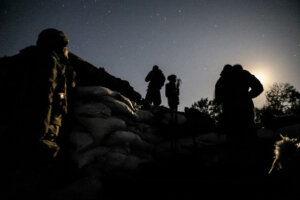
Ukrainian soldiers serve during the night shift at the military positions near Zolote on Sept. 10, 2019. (Oleg Petrasiuk)
Signs of peace
President Volodymyr Zelensky pledged to end the war during the presidential campaign that got him elected on April 21. Now he is urging the resumption of peace negotiations between Ukraine and Russia with the mediation of France and Germany in the Normandy Format.
Zolote is part of the agenda. If the talks bring the countries back to the Minsk peace plan, signed in 2015 but never fulfilled, Zolote is the next place where the Ukrainian and Russian-proxy troops should retreat simultaneously as part of the disengagement process.
The first-ever disengagement took place in late June in Stanytsia Luhanska, a town 90 kilometers east from Zolote.
The disengagement would widen the no-man’s land between the two sides. In Zolote right now it’s sometimes as narrow as 50 meters. Soldiers not only see their adversaries, but are close enough to hear each other’s swearing.
They also remain an easy target. More than 80 Ukrainian soldiers were killed in action since the beginning of 2019, according to the official reports. The disengagement could decrease the number of casualties.
At the same time, some locals fear the disengagement. They worry that when the Ukrainian army retreats, the pro-Russian troops, who have a stronghold in Luhansk, could invade the area.
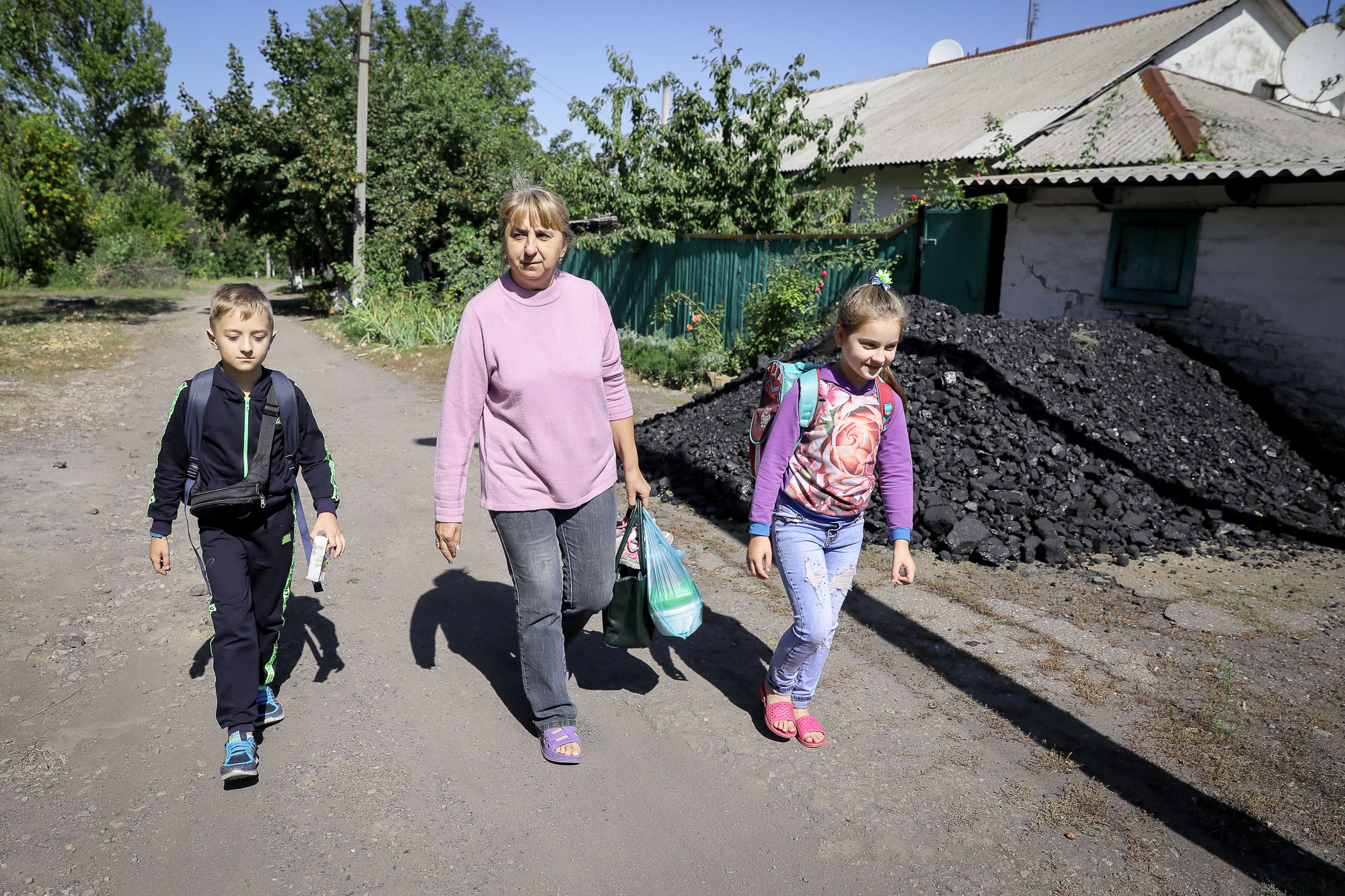
A woman walks her children home from school in the frontline town of Zolote on Sept. 11, 2019. (Oleg Petrasiuk)
Yet some residents are hoping for just that. After years of watching Russian propaganda on television, they think their lives might improve under the Russia-backed separatists.
Neither soldiers nor civilians understand when and how the disengagement may take place.
“If peacekeepers come between us, it would be fine. But if we retreat and (Russian-proxy militants) come in, the war will just resume,” said Mykola, a 23-year-old soldier, standing at one of many Ukrainian army checkpoints in Zolote.
The idea of inviting foreign peacekeepers to Donbas circulated widely in Ukraine under former President Petro Poroshenko, but it is rarely mentioned now. Other soldiers say the disengagement may start only when there is no shooting in this area for a month, which has never happened in Zolote so far.
Victims of war in Zolote
Zolote is a mining town. Only one of its three coal mines still works today.
Its old slag heaps, a river and a railroad create a crooked landscape. There are many sidewalks that snake around the heaps. Residents use them to get to the other side of the front line. Children walk to school along the railways. This part of Zolote is closest to the frontline. Until 2017, it was a popular spot for smuggling.
It’s also where civilians are sometimes killed by landmines. Soldiers on both sides place the mines here to prevent the coming of the enemy’s reconnaisance and subversive groups.
In October 2018, a man and a woman were killed by landmines here when they went to repair the electric cable broken by shelling. It took the authorities several days to remove their bodies from the minefield.
At least seven civilians have been killed in Zolote since the beginning of the war, according to media reports. At least 19 civilians have been killed and 100 wounded in the Donbas warzone between the beginning of the year and until Aug. 15, according to the United Nations.
Ohorodnichuk knows the dangers of Zolote well.
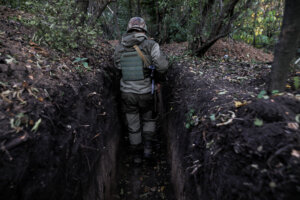
Ukrainian army soldier walks through a trench in Zolote late on Sept. 10, 2019. (Oleg Petrasiuk)
In November, she spent several hours lying on the ground when shelling caught her on the way home. In summer, she endured two small strokes because of stress. Now she lives with her mother and two children in a tiny one-room apartment in the other part of Zolote, which the state gave her for one year. It is considered a safe part of town.
She misses her old apartment, where the soldiers live now, but she has little hope she will ever live there again. During her night watch shift in the local school, Ohorodnichuk drinks tea and watches movies on her smartphone. When she walks outside, she sees the stars and hears the sounds of shooting.
“Nobody knows for how long this war will last,” she said.
Strange war
At the dawn of Sept. 11, Valentyn quietly walks through the bushes. He stops for a while and listens, looking for movement from the hostile territory. The bushes he sees across the field are controlled by the Russian proxies, the field between them belongs to no one.
A day earlier, a pro-Russian fighter in a ghillie suit — a camouflage outfit that makes the wearer look something like a swamp monster — came out of the same bushes where Valentyn stands now and approached dangerously close to Ukrainian positions. He exchanged fire with the Ukrainian troops and quickly retreated.
At night, Valentyn talks about the war in Donbas and compares it to other wars he read about in books. The close sounds of mortars and machine guns interrupt him. Mice scramble under the sacks soldiers use for fortification.
Valentyn volunteered for the army in 2014, the year when the war started. He comes from a village in Cherkasy Oblast, which he proudly calls the geographic center of Ukraine. Just like Ohorodnichuk, he has two children and says his family suffers a lot from rarely seeing him over these years and worrying greatly about him.
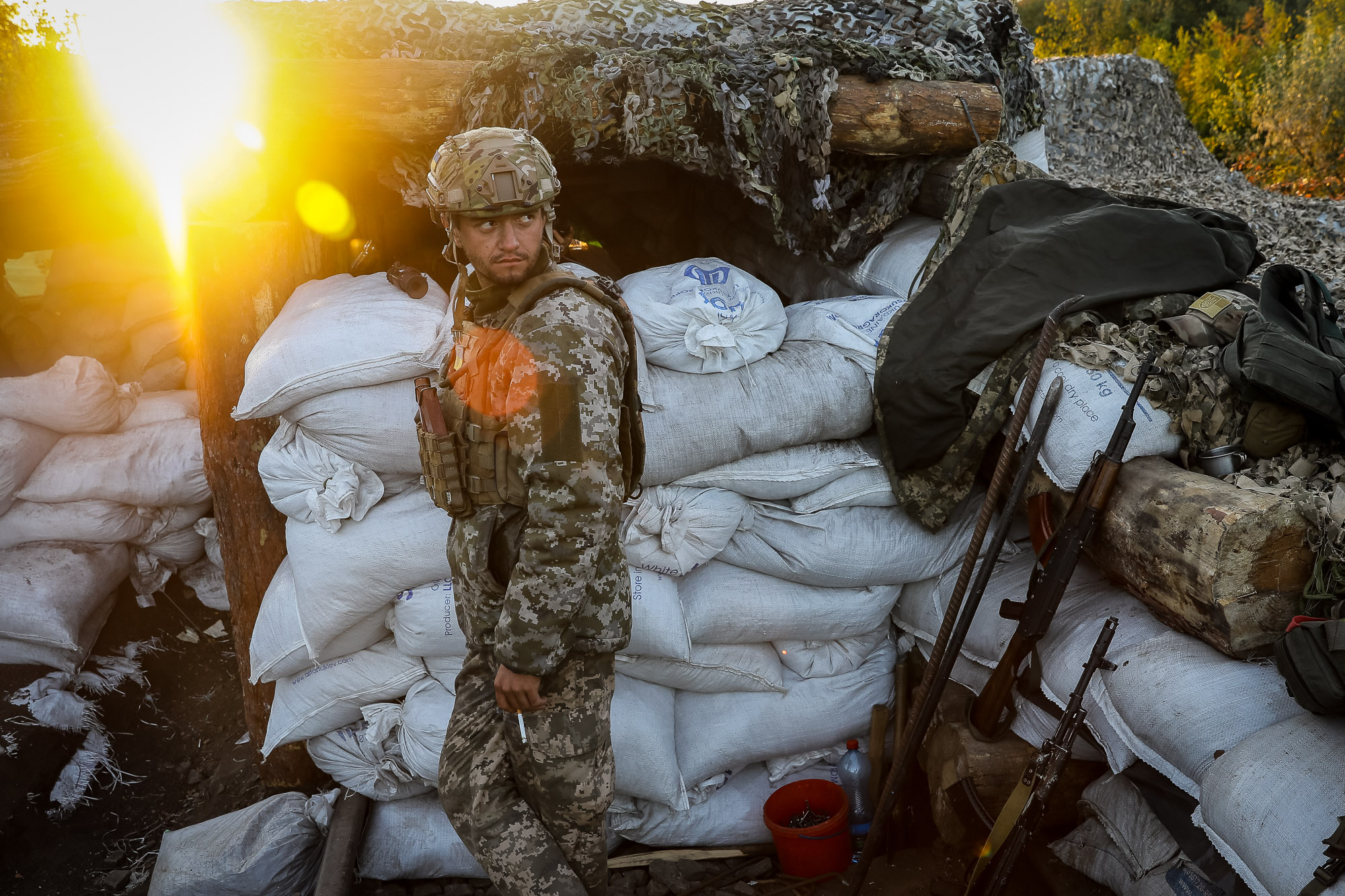
Sergiy, a soldier of the 72nd brigade, smokes a cigarette at a military position of the Ukrainian Army in Zolote early on Sept. 11, 2019. (Oleg Petrasiuk)
Valentyn says the hardest thing for him has been seeing the deaths of 20-year-old soldiers, the age of his son. More than 80 Ukrainian soldiers were killed in the war since the beginning of the year, according to official reports. Overall, more than 3,000 Ukrainian soldiers were killed since the beginning of the war.
As the front line remains almost unchanged since 2015, soldiers admit it is psychologically hard to stay for years without advancement.
In 2014, the Ukrainian army made big advances but also endured major losses. Now, soldiers doubt they will enter the strongholds of Russian proxies in Donetsk and Luhansk anytime soon because it would require huge military and civilian losses again. They don’t want to move back following the disengagement process but admit that if they get an order they will have to follow it.
No one makes plans
Every morning, residents of Zolote gather in a small grocery shop to buy fresh bread and share the news. They usually talk about the shooting they heard the night before. Children do the same at school.

Residents of Zolote buy fresh bread and other products at a shop on Sept. 10, 2019. (Oleg Petrasiuk)
“You are lucky, it was fine last night. Usually, they shoot so heavily that the windows are trembling like they could shatter,” said Iryna, a sixth-grader in Zolote. She turned 11 on Aug. 24, Ukraine’s Independence Day.
In July, a shell broke the roof of her school. The locals plastered the roof, hoping it would be enough for the school to stay warm in the winter.
Last school year was tough in Zolote, said school principal Halyna Yeremeyeva. She said she slept most nights on the floor because of the shooting. The worst nights she spent on the floor of her bathroom, under the sink.
Yeremeyeva said her son has been trying to persuade her to leave Zolote but she has refused because of her school, her pets, and her memories.
“I have two old blind hens, a rooster, a dog, and three cats. How can I leave them all?” she says.
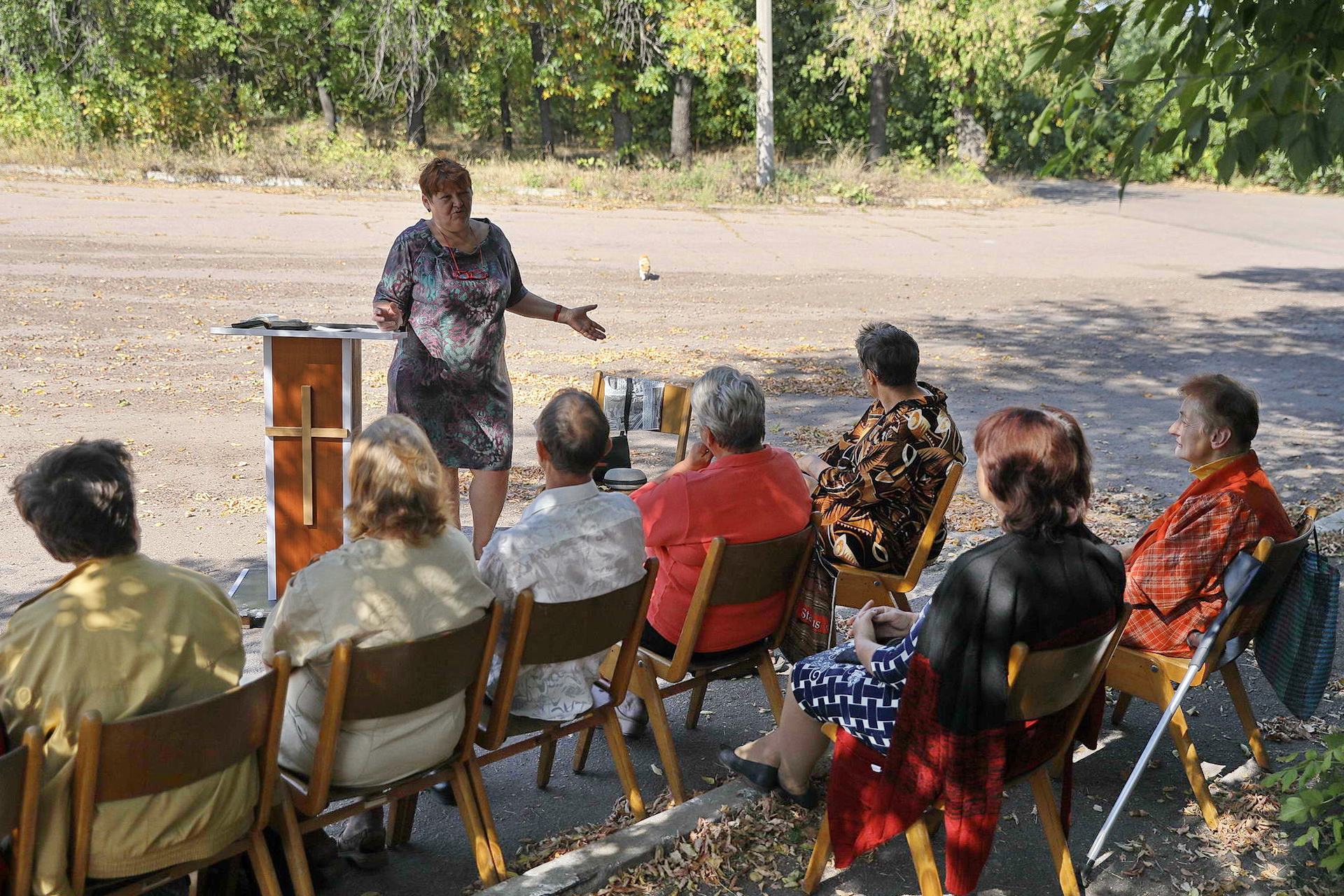
A church leader talks about patience and peace during a weekly meeting of parishioners from the Good News evangelical congregation in Zolote on Sept. 10, 2019. (Oleg Petrasiuk)
The shooting got quieter in the last few weeks, and the locals say that the crossing point in Zolote between the government and the Kremlin-controlled parts of Luhansk Oblast could be opened soon. Ukrainian authorities established the crossing point in Zolote back in 2017, but it has never worked because the Russia-backed militants never agreed to open it from their side.
“They have announced the opening of the crossing point six times already,” Yeremeyeva said. “And we are afraid of this news because the shooting usually intensifies when they (make these announcements).”
Many locals regret that they can’t visit their relatives in the Russian-controlled part of Donbas.
Mykola Shamrin, 69, has a son living there, across the railways. Shamrin rarely sees his children but looks after his grandchildren who live with him and go to a local school.
Shamrin was a miner at the local mine, Rodina. It shut down in the 1990s and is now flooded. He and his wife live off their garden and graze their two cows even though there are many landmines in this area.
“Those who haven’t been here can’t understand how we live,” he says.
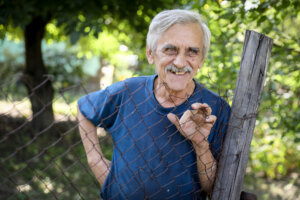
Mykola Shamrin, a former miner, smiles as he talks through the fence of his house in Zolote on Sept. 10, 2019. (Oleg Petrasiuk)
Both soldiers and residents try not to plan ahead and count the past in terms of the destruction and killings they saw over the years.
“What is horrible about this war is that people stopped making plans for the future,” says Roman, 25, a Ukrainian soldier based near Zolote.
